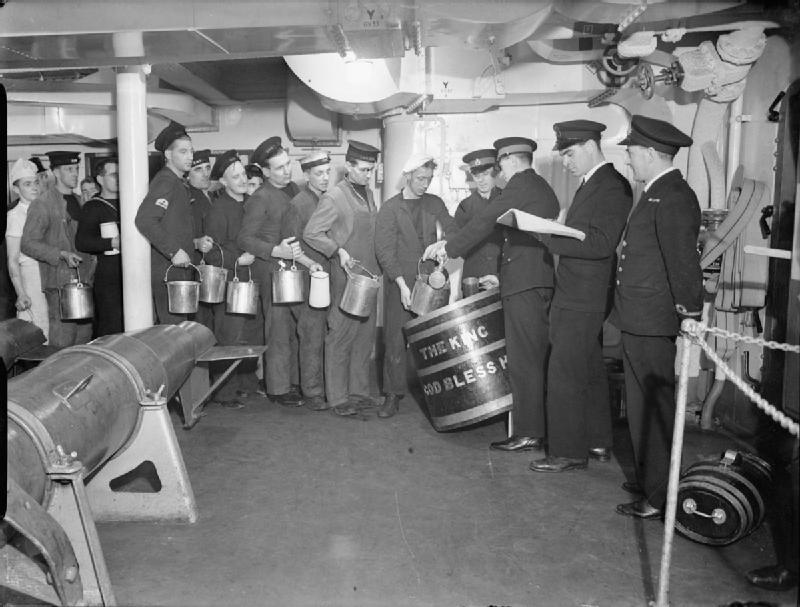Rule Britannia: The Royal Navy and Modern Drinking Culture

As the craft cocktail movement firmly entrenches itself in the United States and abroad, people have become obsessed with recreating the “Golden Age of Cocktails.” Many people erroneously believe this to have been the “Roaring Twenties,” calling to mind images of nattily dressed sophisticates drinking in some Manhattan speakeasy whilst doing the Charleston and Lindy Hop. Dozens of modern day bartenders wearing vests, ironic mustaches, and sleeve garters might agree with them, but in reality, the era that spawned many of today’s terrific tipples was well before the Twenties.
The post-revolutionary and antebellum periods gave the world some of its most ubiquitous cocktails, and the reconstruction period only expanded the beverage lexicon. When one considers the quintessential “classics”, the Mint Julep, Sazerac, and Old Fashioned probably come to mind. And these were all created in the 18th and 19th centuries. In modern times, it’s easy to think of the characters of Mad Men knocking back eight martinis during lunch and then going back to the office to flirt with their secretaries. In reality, the first cocktails were more likely consumed by the characters in Master and Commander, who then stumbled below decks to flirt with the cabin boys.
Drinking and the Royal Navy have a storied history, the quintessential representation of which is the rum ration. Originally, sailors were given a half-gallon of beer twice daily during their service. This tradition continued through the Napoleonic Wars until rum eventually supplanted beer as the Navy’s drink of choice, thanks in large part to influence from trading powers in the British West Indies. It’s likely that the term “proof” (as it relates to alcohol) came from Royal Navy personnel of this time period, as sailors would supposedly soak grains of gunpowder with their rum ration. If the gunpowder still touched off, this was “proof” that the alcohol was above 57% ABV (alcohol by volume). Navy strength rums such as Smith and Cross and Pusser’s maintain their high ABV to this day. Unfortunately, the rum ration was pared down over the next two hundred some odd years, before finally being disposed of on 31 July 1970, also known as Black Tot Day. Sailors were reportedly so displeased with the cessation of the rum ration that they threw their tots into the sea, and in one case held a funeral for their fallen tradition.
It’s not just officially sanctioned drinking that defines the Royal Navy’s ethos though – it’s the notion of how to officially sanction drinking while also coopting colonial cultures as well. When the British East India Company arrived in India in the early 1600s, they took a traditional hot Indian drink known as Panj (Sanskrit for “five,” so-called because it had five ingredients: alcohol, sugar, lemon, water, and tea/spices) and made it their own. From there, the Anglicized “punch” proliferated throughout the British Empire and other European countries, and eventually shifted from wine and brandy to rum. Punch was primarily an officer’s drink, namely because it required citrus and sugar, items far too valuable to give to the rank and file. Admiral Edward Russell, the First Earl of Orford, is once said to have thrown a party with a fountain of punch so large a cabin boy was tasked with serving the punch to guests by way of a dinghy. The punch was also said to be so alcoholic that cabin boys had to be swapped on the hour, so that they wouldn’t pass out from inhalation of alcohol vapor. Eventually, punch would come to be one of the most common drinks in both the new and old worlds.
In the pre Black Tot Day era, noncommissioned officers and enlisted men still received their daily liquor ration. However, it became clear almost instantly that men drinking a pint of rum a day were generally some combination of insubordinate, combat ineffective, riddled with malaria and scurvy, or just plain drunk. Enter Admiral Edward “Old Grog” Vernon, whose grogram coat lead to his nickname (it should be noted that Mount Vernon is also named after the admiral). The common understanding is that gin and tonic resulted from the need to protect sailors and soldiers abroad from malaria. Admiral Vernon preceded the venerable G&T and created the first cocktail in an effort to protect his sailors from dehydration and scurvy (although the latter effect was unintentional). Originally, “Grog” was a mixture of semi-potable water and rum. Eventually, Vernon mixed it with citrus to make it taste better. The British Navy was quick to adopt this method of serving rum rations when it discovered the positive effects citrus had on its sailors. Little did he know it would eventually lead to the pejorative colloquialism “limey.” Grog eventually made it to shore as well, and laid the foundation for cocktail creation in the western hemisphere.
To this day, the British Navy has a toast for each day of the week. The sailors always salute the monarch first, and then commemorate their friends, family, or fellow sailors in a raising of the glass. The command to “splice the mainbrace (essentially, break out the booze)” is still given by members of the Royal Family to commend meritorious service to the crown. Drinking is still as much a part of their ethos as it is for western culture. So remember, the next time you raise your glass, look towards Britain, have yourself a Churchill-esque bow, shout “up spirits!” and drink your rum to the men who came before, drunk on seawater-laced rum and fighting privateers off the coast of Bermuda.
Alex Hecht is editor of Molotov Cocktail. He works as a Security Analyst in Washington, DC. Before working for the man, he managed the Gibson, a cocktail bar in DC’s U Street corridor. Alex’s life is admittedly mellower now, but his liver probably thanks him for that.

